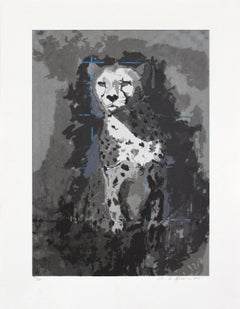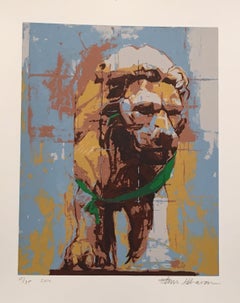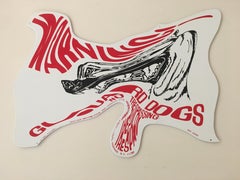Berkshires - Animal Prints
to
1
1
Overall Width
to
Overall Height
to
2
2
2
2
3,180
2,029
Item Ships From: Berkshires
"Cheetah (black & white)"
Located in North Adams, MA
"Cheetah (black & white)," Amir Akhavan, 2017
Silkscreen and iridescence on 290 gram Coventry Rag paper
Dimensions: 25" x 19.25"
Signed and numbered by the Artist in pencil
An editio...
Category
21st Century and Contemporary Contemporary Berkshires - Animal Prints
Materials
Screen
"Portrait of a Lion (Green Ribbon)"
Located in North Adams, MA
To Amir Hossein Akhavan, “nature” is not an abstraction. “Nature is not the forest and the trees as we so often define it, but all is nature.” Nor is painting an abstraction. The sub...
Category
21st Century and Contemporary Contemporary Berkshires - Animal Prints
Materials
Screen
Related Items
I've Got Your Lipstick
By David Shrigley
Located in Bristol, GB
Screenprint
Edition of 125
Numbered on the reverse
Excellent. Minor soft creasing in bottom left and right of print.
AllRightsReserved Ltd
The seller can only provide the specific e...
Category
21st Century and Contemporary Contemporary Berkshires - Animal Prints
Materials
Screen
I Destroyed The Tennis Ball And I Would Like To Destroy More
By David Shrigley
Located in Bristol, GB
26 colour screenprint on somerset satin tub sized 410gsm
Edition of 125
75 x 56 cm (29.5 x 22 in)
Signed and numbered on the back
Mint. Minor imperfections may appear due to the prod...
Category
2010s Contemporary Berkshires - Animal Prints
Materials
Screen
$4,482
H 29.53 in W 22.05 in
David Shrigley - I Will Not Allow The Dark Skies To Affect Me
By David Shrigley
Located in London, GB
David Shrigley
I Will Not Allow The Dark Skies To Affect Me, 2024
Screenprint on 300gsm BFK Rives paper
76 x 56 cm
Edition 80 of 125
Hand-signed and numbered by the artist
published...
Category
2010s Contemporary Berkshires - Animal Prints
Materials
Screen
$4,655 Sale Price
25% Off
H 29.93 in W 22.05 in
David Shrigley - Everything is Good
By David Shrigley
Located in London, GB
David Shrigley
Everything is Good, 2023
Screenprint on 300gsm BFK Rives paper
76 x 56 cm
Edition of 125
Hand-signed and numbered by the artist
published by NGV
David Shrigley is a B...
Category
2010s Contemporary Berkshires - Animal Prints
Materials
Screen
$4,414 Sale Price
20% Off
H 29.93 in W 22.05 in
I Will Not Allow The Dark Skies To Affect Me
By David Shrigley
Located in Bristol, GB
22 Colour Screenprint with Varnish Overlay on Somerset Tub Sized 410gsm Paper
Edition 47 of 125
76 x 56 cm (29.5 x 22 in)
Signed, numbered and dated on the back
Mint. Minor imper...
Category
21st Century and Contemporary Contemporary Berkshires - Animal Prints
Materials
Screen
Ai Weiwei, Cats (Black) - Signed Print, Contemporary Art, Chinese Activist
By Ai Weiwei
Located in Hamburg, DE
Ai Weiwei (Chinese, b. 1957)
Cats (Black), 2022
Medium: Screenprint on paper
Sheet dimensions: 28 x 32.8 cm
Frame dimensions: 36.1 x 41.2 cm
Edition of 150: Hand-signed, numbered and...
Category
21st Century and Contemporary Contemporary Berkshires - Animal Prints
Materials
Screen
$3,578
H 11.03 in W 12.92 in
Mini crab, Limited edition print, Animal art, Sea Art
By Gavin Dobson
Located in Deddington, GB
A hand crafted five layer screen print of a painted illustration by the artist of a crab on heritage white paper. With a final layer hand glittered.
ADDITIONAL INFORMATION:
Handmade...
Category
2010s Contemporary Berkshires - Animal Prints
Materials
Screen
$110
H 8.27 in W 5.83 in D 0.04 in
Ebu, Pop Art Silkscreen by Hunt Slonem, 1981
By Hunt Slonem
Located in Long Island City, NY
This serigraph was created by contemporary American artist Hunt Slonem. Slonem is best known for his Neo-Expressionist paintings and bright tropical palette, and his subject matter o...
Category
1980s Contemporary Berkshires - Animal Prints
Materials
Screen
Fish Dinner /// Contemporary Pop Art Screenprint Black and White Food Dinner Eat
By Dan May
Located in Saint Augustine, FL
Artist: Dan May (American, 1955-)
Title: "Fish Dinner"
*Signed and numbered by May in pencil lower left
Year: 1988
Medium: Original Screenprint on unbrande...
Category
1980s Contemporary Berkshires - Animal Prints
Materials
Screen
$250
H 12.25 in W 10.13 in
GDP Rat (Framed)
By Banksy
Located in Manchester, GB
Banksy, GDP Rat, 2019
Screenprint on 50 gsm paper
38.5 x 50.5 cm (15 1/5 x 19 9/10 in) (Unframed)
Very good condition, the paper has naturally occurring waves from the screen print...
Category
2010s Contemporary Berkshires - Animal Prints
Materials
Paper, Screen
Duck out of Water, Mixed Media Print by Raymond Saunders
By Raymond Saunders
Located in Long Island City, NY
Artist: Raymond Jennings Saunders, American (1934 - )
Title: Duck Out of Water
Year: 1975
Medium: Lithograph with Screenprint and Collage, signed and numbered in pencil
Edition: 200...
Category
1970s Contemporary Berkshires - Animal Prints
Materials
Lithograph, Screen
You Will Not Stop Me From Singing My Song
By David Shrigley
Located in Bristol, GB
27 colour screenprint with a varnish overlay
Edition of 125 + 4 AP's
Signed and numbered on the reverse
Very good. Minor soft crease on bottom left corner of print visible under raki...
Category
21st Century and Contemporary Contemporary Berkshires - Animal Prints
Materials
Screen
Previously Available Items
"Guard Dog Sign"
By Robert Lazzarini
Located in North Adams, MA
"Guard Dog Sign," Robert Lazzarini, 2010
Silkscreen on epoxy painted laser cut aluminum
Dimensions: 14" x 16.5"
An edition of 24
Robert Lazzarini is ...
Category
21st Century and Contemporary Contemporary Berkshires - Animal Prints
Materials
Screen
"When the Elevator Door Opens"
Located in North Adams, MA
PHIL SMITH: ARTIST’S STATEMENT / BIO
I am a poet, writer, musician, artist and teacher. I began writing poetry when I was 8 years old and became a well-published poet and editor (Ge...
Category
21st Century and Contemporary Contemporary Berkshires - Animal Prints
Materials
Screen
Recently Viewed
View AllMore Ways To Browse
Robert Ernst Marx Prints
Robert Ernst Marx
Rodrigue City Slicker
Rodrigue Pueblo Puppies
Rodrigue The Rat Pack
Rolf Knie
Saw Whet Owl
Wilfred Fairclough
19th Century Goya Bullfighting Prints
Basil Ede Art
Basil Ede Print
Basil Ede
Braque Deux Oiseaux
Britto Dog
David Le Batard
David Shrigley Fish
David Shrigley I Am Listening
Descourtilz Jean Theodore


